Accepted Scientific Name: Cyphostemma juttae (Dinter & Gilg) Desc.
Naturalia Monspel., Sér. Bot. 18: 222, basionymo cit. 1967 Remarks: [NON GCI] Descoings (Notul. Syst. (Paris) 16: 122. 1960) published this comb. nov. invalidly (basionym reference lacking)
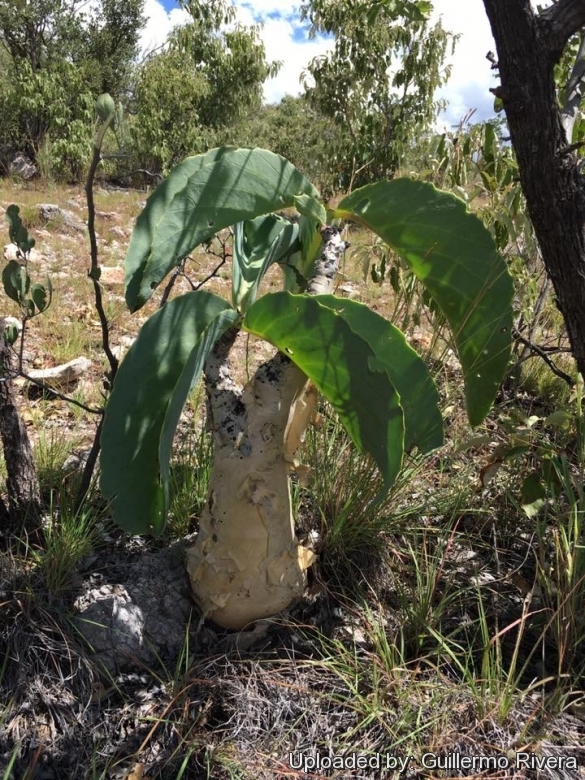
Cissus juttae (Cyphostemma juttae) Photo by: Guillermo Rivera
Namibia 2017. Around Grootfontein, South of Opuwo.
Origin and Habitat: Namibia from Walvis Bay northwards up to the Kunene River and further east, up to Windhoek and in the Otavi Mountains. This species is known from at least 20 subpopulations, with an extent of occurrence around 20,000 km².
Habitat: It grows in rocky, arid areas covered by open, semi-tropical, fly-infested forest exposed to very dry and hot conditions. It seems to prefer dolomite. When conditions are especially severe, Cyphostemma sheds all its leaves, as these are large and permit water to evaporate. The plant’s acrid taste and poisonous qualities help keep hungry animals away. Population size is suspected to be declining due to collecting.
Synonyms:
Common Names include:
ENGLISH: Elephant's Foot, Butter bush, Tree Grape, Bastard Cobas, Wild grape, Namibian grape, Droog-my-keel, blue kobas
AFRIKAANS (Afrikaans): Jutta's botterboom, Botterboom, Basterkobas
CHINESE (中文): 葡萄瓮
SPANISH (Español): Cobas bastardo, Uva silvestre, Uva de árbol, Uva de Namibia
Description: Cyphostemma juttaeSN|11031]]SN|11031]], probably the most common of the genus, is a slow-growing succulent ornamental tree with several huge swollen bottle-shaped stems or one thick stem bearing a spreading crown of branches. The broad serrated, blue-green leaves forms a bizarre compact canopy at the top. Every winter it sheds those succulent leaves completely, leaving only the swollen stem. Flowers borne in early summer are inconspicuous but the grape-like bunches of fruit are red, and later purple and definitely attract attention.
Stem: The thick swollen stem or caudex (which makes this plant a caudiciform) usually grows up to 2 m tall and 1 m thick (occasionally to 4 m in height ) and acts as water reservoirs in times of drought. Branches few upright growing, almost as thick as the main stem, tapering. The trunk and branches are thick, woody yellow-green with a white, peeling, papery bark that is very typical of this species. In summer this bark helps to reflect away the sunlight in order to keep the plant cool.
Leaves: Deciduosus, emerging each spring at branch tips but falling off going into the winter months. Thick, fleshy, leathery and dimorphic: juvenile plants have simple though deeply lobed leaves. Upon maturing they may become trifoliolate (having three leaflets) and they develop a characteristic winged leaf-stalk. Leaf lobes velvety blue-green, shiny, about 15 cm long with serrated (saw-toothed) edges, and very easy to break by just touching. The leaves are an attractive purple colour when first coming up.
Flowers: Inconspicuous, about the same colour as the foliage, maybe more creamy-yellow.
Blooming season: Summer
Fruits: Green turning yellow or wine-colored and eventually almost black, containing very toxic levels of tannins in these, so do not eat. Their delicious appearance is deceiving.
Bibliography: Major references and further lectures
1) Umberto Quattrocchi “CRC World Dictionary of Medicinal and Poisonous Plants: Common Names, Scientific Names, Eponyms, Synonyms, and Etymology” (5 Volume Set) CRC Press, 03/mag/2012
2) Sharon Asakawa, John Bagnasco “Planting Designs for Cactus & Succulents: Indoor and Outdoor Projects for Unique, Easy-Care Plants--in All Climates” Cool Springs Press, 15/Jan/2014
3) van Wyk, B. and van Wyk, P. “Field Guide to trees of southern Africa.” Struik, Cape Town 1997.
4) Kristo Pienaar “The South African what Flower is That?” Struik, 2000
5) Gordon Rowley “Caudiciform and Pachycaul Succulents: Pachycauls, Bottle-,Barrel-And Elephant-Trees and Their Kin a Collector's Miscellany” Strawberry Press. June 1st 1987
6) Werner Rauh “The Wonderful World of Succulents: Cultivation and Description of Selected Succulent Plants Other Than Cacti” Smithsonian Institution Press, 1984
7) Sean Hogan “Flora: A Gardener's Encyclopedia” Volume 1 Timber Press, 2003
8) Craven, P. 2004. “Cyphostemma juttae.” In: IUCN 2013. “IUCN Red List of Threatened Species.” Version 2013.2. <www.iucnredlist.org>. Downloaded on 06 June 2014.
9) Gibbs Russell, G. E., W. G. Welman, E. Reitief, K. L. Immelman, G. Germishuizen, B. J. Pienaar, M. v. Wyk & A. Nicholas. “List of species of southern African plants.” Mem. Bot. Surv. S. Africa 2(1–2): 1–152(pt. 1), 1–270(pt. 2).1987
10) BARKUIZEN, B.P. “Succulents of southern Africa.” Purnell, Cape Town.1987
11) JOFFE, P. “The gardeners guide to South African plants.” Tafelberg, Cape Town.1993
12) Hans Hoefer, Johannes Haape "Namibia" Apa Publications, 1993
13) Denise Greig "Ornamental Foliage Plants" Firefly Books, 2004
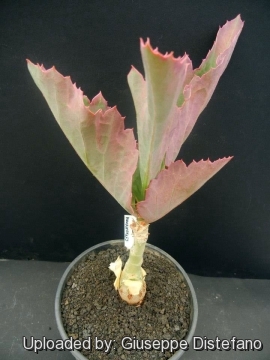 Cissus juttae (Cyphostemma juttae) Photo by: Giuseppe Distefano
Cissus juttae (Cyphostemma juttae) Photo by: Giuseppe Distefano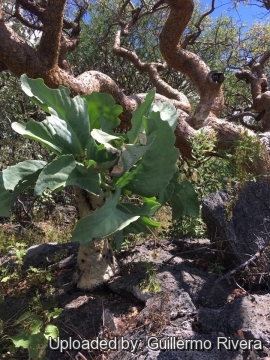 Cyphostemma juttae in habitat. Namibia 2017 (Cyphostemma juttae) Photo by: Guillermo Rivera
Cyphostemma juttae in habitat. Namibia 2017 (Cyphostemma juttae) Photo by: Guillermo Rivera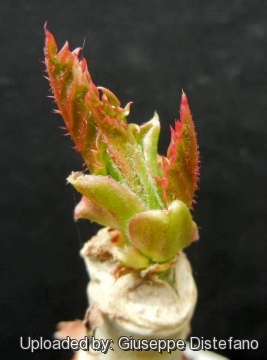 Cissus juttae (Cyphostemma juttae) Photo by: Giuseppe Distefano
Cissus juttae (Cyphostemma juttae) Photo by: Giuseppe Distefano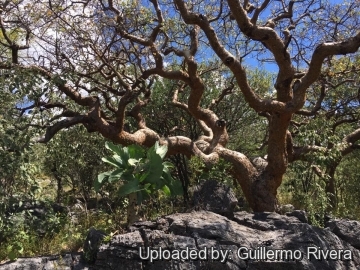 Cyphostemma juttae in habitat. Namibia 2017 (Cyphostemma juttae) Photo by: Guillermo Rivera
Cyphostemma juttae in habitat. Namibia 2017 (Cyphostemma juttae) Photo by: Guillermo Rivera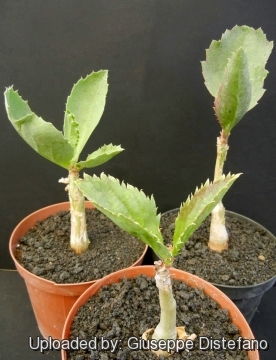 Cissus juttae (Cyphostemma juttae) Photo by: Giuseppe Distefano
Cissus juttae (Cyphostemma juttae) Photo by: Giuseppe DistefanoSend a photo of this plant.The gallery now contains thousands of pictures, however it is possible to do even more. We are, of course, seeking photos of species not yet shown in the gallery but not only that, we are also looking for better pictures than those already present.
Read More... Cultivation and Propagation: Cyphostemma juttae is easy to grow, does well in the ground, and makes an impressive specimens, though fairly slow growing. It is also suited to greenhouse culture but do well out of doors in Mediterranean climate. It doesn't like the wet winter but will survive.
Soil: A fast-draining rich, well drained cactus mix should be used when potting. Outdoor plant it in a loamy or sandy soil where drainage is optimal.
Watering: It is drought tolerant, but it appreciates plentifully of water and some fertilizer during the summer growing season, but keep dry in winter in order to prevent rotting. As with all succulents one must be careful not to over-water. These plants can survive with very little water and too often plants die as a result of too much water. Despite coming from areas that are dry in winter, it can adapt to wet-winter areas like coastal California. If one lives in a very wet area, it is best to rather keep plants in big containers where they can be easily moved to a sheltered place.
Exposure: It like lots of sun throughout the year.
Hardiness: Mature plants are hardy to -3° C (or less), but it is best to avoid freezing temperatures especially if the plants are young. Cyphostemma comes from the hot, dry areas of southern Africa, so it has no problem taking temperatures up to 40° C; however, it may need some afternoon shade in hot climates to avoid leaf burn.
Garden uses: Cyphostemma are very sought-after plants for the garden, as are other caudiciform plants such as baobabs, adeniums and tylecodons. They make superb container or open garden subjects in and around the garden, especially around swimming pools and courtyards. They are ideal accent plants for a rockery, or may be planted in a large container on a sunny protected patio.
Traditional uses: Bushmen in southern Africa use the juice of Cyphostemma to poison the tips of their arrows. The smooth papery bark comes off in fairly large strips and has been used locally to transport honeycomb retrieved from bee's nests by hunter gatherers.
Propagation: Propagate usually from seed that must be prepared, aged and scarified and even then germination is uncertain or by cuttings. Plant seeds in winter 1-2 cm deep in moist, sterile soil. Keep soil temperature consistent at 20-30° C, with some day/variation in this range. Cool soils will significantly delay seed germination time if not inhibit germination altogether. Because seeds need a very long time for germination, take care to use sterile soil, do not re-use soil that was used for other plantings. It is also recommended seeds be germinated in a high humidity environment so constant watering is not necessary. Either germinate seeds in a greenhouse or make a temporary "greenhouse" by covering containers with plastic wrap, or by putting containers inside a ziplock bag. Monitor for fungal growth and air out if/when necessary. Germination tends to be slow and erratic. 6-12 months, sometimes up to 24 months. Propagation can also be undertaken by means of cuttings. Cuttings or truncheons can be made in coarse river sand. Again it is important to water with caution especially when cuttings have rooted.
Warning: The grape-like berries are very dcorative but unlike the edible grape they are poisonous.
















